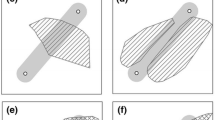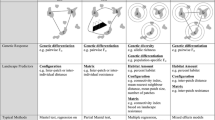Abstract
A scientific symposium on landscape genetics, held at the 2013 IALE Europe Conference in Manchester UK (September 2–8, 2013), highlighted status, challenges and future avenues in the field. Key topics included analytical aspects in landscape genetics, conceptual progress and application of landscape genetics for conservation management. First, analytical aspects referred to statistical relationships between genetic and landscape data. It was suggested that linear mixed models or Bayesian approaches are particularly promising due to more appropriate and powerful ways for analyzing landscape effects on genetic variation. Second, supplementing neutral genetic variation with adaptive genetic variation is very promising. However, research needs to go beyond the identification of genomic regions under selection and provide information on the ecological function of adaptive genetic regions. Conceptually, endogenous processes (e.g., life-history attributes such as dispersal) require consideration as supplementary factors in shaping the genetic variation in addition to landscapes. Also, the temporal dimension in landscapes for both the past and the future should be given increased attention as the genetic responses to landscape change may be non-simultaneous, resulting in time lags. As for applied conservation management, landscape genetics can provide important baseline information such as basic data on species movement in a spatial context, assessments of the spatial need for management efforts, or evaluations of the effectiveness of already existing management measures.
Similar content being viewed by others
References
Aavik T, Edwards P, Holderegger R, Graf R, Billeter R (2012) Genetic consequences of using seed mixtures in restoration: a case study of a wetland plant Lychnis flos-cuculi. Biol Conserv 145:195–204
Aavik T, Holderegger R, Bolliger J (2013) The structural and functional connectivity of the grassland plant Lychnis flos-cuculi. Heredity. doi:10.1038/hdy.2013.120
Andreasen AM, Stewart KM, Longland WS, Beckmann JP, Forister ML (2012) Identification of source-sink dynamics in mountain lions of the Great Basin. Mol Ecol 21:5689–5701
Angelone S, Kienast F, Holderegger R (2011) Where movement happens: scale-dependent landscape effects on genetic differentiation in the European tree frog. Ecography 34:714–722
Balkenhol N, Gugerli F, Cushman SA, Waits LP, Holderegger R, Wagner HH (2009a) Participants of the Landscape Genetics Research Agenda Workshop 2007 Identifiying future research needs in landscape genetics: where to go from here? Landscape Ecol 24:455–463
Balkenhol N, Waits LP, Dezzani RJ (2009b) Statistical approaches in landscape genetics: an evaluation of methods for linking landscape and genetic data. Ecography 32:818–830
Balkenhol N, Holbrook J, Onorato D, Zager P, White C, Waits LP (in press) Multi-method approach for analyzing hierarchical genetic structures: a case study with cougars Puma concolor. Ecography
Blair C, Weigel DE, Balazil M, Keeley ATH, Walker FM, Landguth E, Cushman S, Murphy M, Waits L, Balkenhol N (2012) A simulation-based evaluation of methods for inferring linear barriers to gene flow. Mol Ecol Res 12:822–833
Bolliger J, Sprott JC, Mladenoff DJ (2003) Self-organization and complexity in historical landscape patterns. Oikos 100:541–553
Bolliger J, Keller D, Holderegger R (2011) When landscape variables do not explain migration rates: an example from an endangered dragonfly (Leucorrhinia caudalis). Eur J Entomol 108:327–330
Clark RW, Brown WS, Stechert R, Zamudio KR (2008) Integrating individual behaviour and landscape genetics: the population structure of timber rattlesnake hibernacula. Mol Ecol Res 17:719–730
Cushman SA, Landguth EL (2010) Spurious correlations and inference in landscape genetics. Mol Ecol 19:3592–3602
Cushman SA, Lewis JS (2010) Movement behavior explains genetic differentiation in American black bears. Landscape Ecol 25:1613–1625
Epperson BK, McRae BH, Scribner K, Cushman SA, Rosenberg MS, Fortin MJ, James PMA, Murphy M, Manel S, Legendre P, Dale MRT (2010) Utility of computer simulations in landscape genetics. Mol Ecol 19:3549–3564
Epps CW, Castillo JA, Schmidt-Kuentzel A, du Preez P, Stuart-Hill G, Jago M, Naidoo R (2013) Contrasting historical and recent gene flow among African buffalo herds in the Caprivi strip of Namibia. J Hered 104:172–181
Frankham R, Ballou JD, Briscoe DA (2002) Introduction to conservation genetics. Cambridge University Press, Cambridge
Graves TA, Beier P, Royle JA (2013) Current approaches using genetic distances produce poor estimates of landscape resistance to interindividual dispersal. Mol Ecol 22:3888–3903
Hanks EM, Hooten MB (2013) Circuit theory and model-based inference for landscape connectivity. J Am Stat Assoc 108:22–33
Helm A, Hanski I, Partel M (2006) Slow response of plant species richness to habitat loss and fragmentation. Ecol Lett 9:72
Holderegger R, Kamm U, Gugerli F (2006) Adaptive versus neutral genetic diversity: implications for landscape genetics. Landscape Ecol 21:797–807
Jaquiery J, Broquet T, Hirzel AH, Yearsley J, Perrin N (2011) Inferring landscape effects on dispersal from genetic distances: how far can we go? Mol Ecol 20:692–705
Jones FA, Muller-Landau HC (2008) Measuring long-distance seed dispersal in complex natural environments: an evaluation and integration of classical and genetic methods. J Ecol 96:642–652
Jones MR, Forester BR, Teufel AI, Adams RV, Anstett DN, Goodrich BA, Landguth EL, Joost S, Manel S (2013) Integrating landscape genomics and spatially explicit approaches to detect loci under selection in clinal populations. Evolution 67:3455–3468
Joost S, Bonin A, Bruford MW, Despres L, Conord C, Erhardt G, Taberlet P (2007) A spatial analysis method (SAM) to detect candidate loci for selection: towards a landscape genomics approach to adaptation. Mol Ecol 16:3955–3969
Joost S, Kalbermatten M, Bezault E, Seehausen O (2012) Use of qualitative environmental and phenotypic variables in the context of allele distribution models: detecting signatures of selection in the genome of Lake Victoria cichlids. Methods Mol Biol (Clifton, N.J.) 888:295–314
Keller D, Brodbeck S, Flöss I, Vonwil G, Holderegger R (2010) Ecological and genetic measurements of dispersal in a threatened dragonfly. Biol Conserv 143:2658–2663
Keller D, Van Strien MJ, Herrmann M, Bolliger J, Edwards PJ, Ghazoul J, Holderegger R (2013) Is functional connectivity in common grasshopper species affected by fragmentation in an agricultural landscape. Agric Ecosyst Environ 175:39–46
Klein EK, Carpentier FH, Oddou-Muratorio S (2011) Estimating the variance of male fecundity from genotypes of progeny arrays: evaluation of the Bayesian forward approach. Methods Ecol Evol 2:349–361
Krauss J, Bommarco R, Guardiola M, Heikkinen RK, Helm A, Kuussaari M, Lindborg R, Öckinger E, Pärtel M, Pino J, Pöyry J, Raatikainen KM, Sang A, Stefanescu C, Teder T, Zobel M, Steffan-Dewenter I (2010) Habitat fragmentation causes immediate and time-delayed biodiversity loss at different trophic levels. Ecol Lett 12:597–605
Kuroe M, Yamaguchi N, Kadoya T, Miyashita T (2011) Matrix heterogeneity affects population size of the harvest mice: bayesian estimation of matrix resistance and model validation. Oikos 120:271–279
Lander TA, Bebber DP, Choy CTL, Harris SA, Boshier DH (2011) The circe principle explains how resource-rich land can waylay pollinators in fragmented landscapes. Curr Biol 21:1302–1307
Landguth EL, Cushman SA, Schwartz MK, McKelvey KS, Murphy M, Luikart G (2010) Quantifying the lag time to detect barriers in landscape genetics. Mol Ecol 19:4179–4191
Legendre P, Fortin MJ (2010) Comparison of the mantel tst and alternative approaches for detecting complex multivariate relationships in the spatial analysis of genetic data. Mol Ecol Res 10:831–844
Manel S, Holderegger R (2013) Ten years of landscape genetics. Trends Ecol Evol 28:614–621
Manel S, Schwartz M, Luikart G, Taberlet P (2003) Landscape genetics: combining landscape ecology and population genetics. Trends Ecol Evol 18:189–197
Manel S, Joost S, Epperson BK, Holderegger R, Storfer A, Rosenberg MS, Scribner KT, Bonin A, Fortin MJ (2010) Perspectives on the use of landscape genetics to detect genetic adaptive variation in the field. Mol Ecol 19:3760–3772
Porter JH, Hanson PC, Lin CC (2012) Staying afloat in the sensor data deluge. Trends Ecol Evol 27:121–129
Reding DM, Cushman SA, Gosselink TE, Clark WR (2013) Linking movement behavior and fine-scale genetic structure to model landscape connectivity for bobcats (Lynx rufus). Landscape Ecol 28:471–486
Reed DH, Frankham R (2001) How closely correlated are molecular and quantitative measures of genetic variation? A meta-analysis. Evolution 55:1095–1103
Sawyer SC, Epps CW, Brashares JS (2011) Placing linkages among fragmented habitats: do least-cost models reflect how animals use landscapes? J Appl Ecol 48:668–678
Segelbacher G, Cushman S, Epperson B, Fortin M-J, Francois O, Hardy O, Holderegger R, Taberlet P, Waits L, Manel S (2010) Applications of landscape genetics in conservation biology: concepts and challenges. Conserv Genet 11:375–385
Storfer A, Murphy MA, Spear SF, Holderegger R, Waits LP (2010) Landscape genetics: where are we now? Mol Ecol 19:3496–3514
Van Strien MJ, Keller D, Holderegger R (2012) A new analytical approach to landscape genetic modelling: least-cost transect analysis and linear mixed models. Mol Ecol 21:4010–4023
Van Strien MJ, Keller D, Holderegger R, Ghazoul J, Kienast F, Bolliger J (in press) Landscape genetics as a tool for conservation planning: predicting the effects of landscape change on gene flow. J Appl Ecol
Yang R-C (2004) A likelihood-based approach to estimating and testing for isolation by distance. Evolution 58:1839–1845
Acknowledgments
We would like to thank the Editor-in-Chief and two reviewers for their very helpful comments on an earlier version of this manuscript.
Author information
Authors and Affiliations
Corresponding author
Rights and permissions
About this article
Cite this article
Bolliger, J., Lander, T. & Balkenhol, N. Landscape genetics since 2003: status, challenges and future directions. Landscape Ecol 29, 361–366 (2014). https://doi.org/10.1007/s10980-013-9982-x
Received:
Accepted:
Published:
Issue Date:
DOI: https://doi.org/10.1007/s10980-013-9982-x




